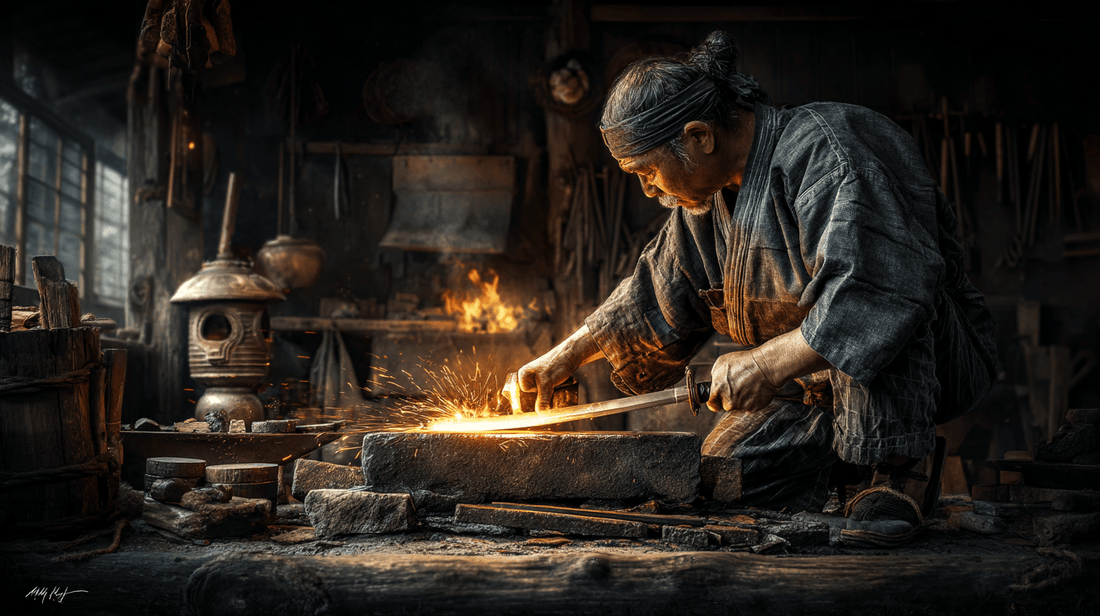
How Katana Is Made – Traditional Forging Process Explained
Share
The question of how katana is made goes beyond metallurgy—it's a spiritual journey, a cultural tradition, and an artistic achievement. The katana is not merely a weapon but a refined embodiment of Japan's rich history and samurai legacy. In this article, we explore the traditional katana forging process from raw steel to razor-sharp blade.
Understanding Tamahagane: The Heart of Katana Forging
Traditional Japanese sword making begins with tamahagane, a special steel produced from iron sand using a clay furnace called a tatara. This steel is crucial to the creation of katana because of its ability to be folded and refined into a perfect balance of hardness and flexibility.
Producing Tamahagane
- Iron sand is smelted over three days in the tatara furnace.
- The process yields high-carbon and low-carbon steel, which is then hand-sorted by the swordsmith.
- Selected pieces are combined to create a steel billet for folding.
To see modern representations of tamahagane-style craftsmanship, check out the Tokyo Katana with Real Hamon from Katana America.
Folding and Forging: Creating Strength Through Layers
The hallmark of samurai sword crafting lies in the folding of tamahagane steel. This process, known as orikaeshi tanren, eliminates impurities and creates thousands of microscopic layers, improving both the sword’s durability and flexibility.
Steps in the Folding Process
- Heat the steel billet until red-hot.
- Hammer it flat, fold it over, and hammer again—repeating up to 16 times.
- The resulting blade contains up to 65,000 layers, giving the katana its unique grain pattern known as hada.
Shaping and Forging the Blade
Once folded, the steel is forged into a blade shape. This includes a process called forge welding to join different steel types together: hard steel for the edge and softer steel for the spine. This balance is essential for creating a katana that is both sharp and resilient.
Swordsmiths then shape the blade with hammers and chisels, forming the iconic curve and preparing it for hardening. The Shusui Katana mirrors many elements of traditional blade geometry in its design.
Differential Hardening: The Hamon Line
A key part of how to make a katana is differential hardening. Swordsmiths apply a clay mixture to the blade before heating it. The edge is coated thinly, while the spine gets a thicker coat. When the blade is quenched in water, this causes the edge to harden faster than the spine, creating the curved shape and distinctive hamon (temper line).
Benefits of Differential Hardening
- Sharp, durable edge that resists wear.
- Flexible spine that absorbs impact.
- Visually beautiful patterns unique to each blade.
This traditional method is reflected in products like the Black Enma Katana, which showcases a visible hamon line.
Polishing and Sharpening the Blade
After forging and tempering, the blade is handed to a skilled polisher. Using whetstones of increasing fineness, the polisher reveals the hamon line, smooths the blade surface, and sharpens it to a razor’s edge. This meticulous step can take several weeks, depending on the level of refinement desired.
Mounting the Katana: Functional Artistry
Every katana requires a customized mount, or koshirae, including:
- Tsuba: The handguard, often ornately decorated.
- Tsuka: The handle, wrapped in ray skin and cord.
- Saya: The scabbard, made of lacquered wood.
Collectors can replicate this traditional look with products like the Classic 3-Place Stand or the Katana Cleaning Kit to maintain authenticity.
Katana Forging Timeline Overview
| Stage | Description | Estimated Time |
|---|---|---|
| Smelting Tamahagane | Extracting steel from iron sand | 3–5 days |
| Folding Steel | Layering and purifying the billet | 1–2 weeks |
| Forging Blade | Shaping and welding components | 1 week |
| Differential Hardening | Creating curve and hamon | 1–2 days |
| Polishing and Mounting | Finishing blade and assembling fittings | 2–3 weeks |
Discover Authentic Katana Designs
Modern enthusiasts can explore handcrafted katana replicas at Katana America's katana collection. Whether you're inspired by traditional Japanese sword making or iconic anime swords like the Zenitsu Katana or Trafalgar Law’s Kikoku, there’s a blade that honors the artistry of the past.
Further Reading and Expert Resources
- Encyclopedia Britannica – Katana
- Nippon.com – Swordsmithing Tradition
- Sword Encyclopedia – How Katanas Are Made
- Met Museum – Japanese Arms and Armor
Conclusion: Honoring the Craft of the Katana
The answer to how katana is made reveals a multi-stage process that is as much about spiritual precision as it is technical excellence. From smelting tamahagane to forging, polishing, and mounting, each step pays homage to the centuries-old traditions of samurai sword crafting.
Explore these traditions yourself at Katana America, where each blade tells a story rooted in legacy, discipline, and unmatched craftsmanship.
